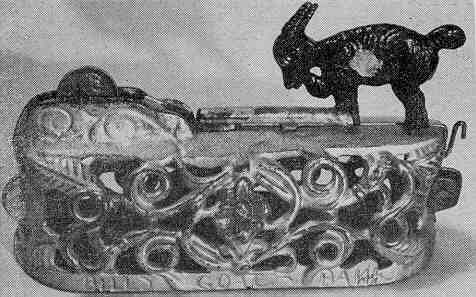Billy Goat Bank
by F.H. Griffith - HOBBIES Magazine - January, 1956

As we reach No. 43 in our numerical classification of mechanical banks we come to another bank that has more appeal to the advanced collector. This bank is the Billy Goat Bank, a rare and desirable item, but not particularly impressive as to appearance and action.
The prolific bank designer, Chas. A Bailey, patented the Billy Goat Bank July 26, 1910, and it was manufactured by the J. and E. Stevens Company of Cromwell, Conn. It’s of interest to note that Bailey also patented the North Pole Bank on the exact same date as the Billy Goat. As a matter of fact the magazine "Playthings" for May, 1910, announced both the North Pole and Billy Goat Bank as newcomers on the market. The North Pole to sell at 50c over the retail counter and the Billy Goat to sell at 25c. Neither one of these banks apparently attained any degree of popularity even though it’s apparent the Billy Goat was put out as a hopeful large seller at the price. And the North Pole to capitalize on the current historical event. Even toy drums with North Pole scenes were hopefully put on the market at the time. In any event, neither one of the banks were made in any great quantity or over any long period of time. It is always well to keep in mind that the length of time a bank was made is a great factor in its being rare or common today, Tammany, and Halls Excelsior, for example, were made year in and year out over a period of many years. Therefore, great quantities of these banks were manufactured and that is the reason they are two of the most common mechanical banks found. Of course popularity and salability of any mechanical bank was the governing factor as to the length of time it was made and the quantity that were manufactured.
Back to Chas. Bailey for a moment, it is well to recognize the large field of his mechanical bank designing. As a matter of fact if a collector only had mechanical banks either made or designed by Bailey he would have an outstanding collection. Bailey’s banks are among the most desirable from all angles, including action, appearance, and clever mechanism. He covered a very broad field with his toy banks even including history and politics in their makeup. Any mechanical bank showing the Bailey touch has an extra measure of desirability and value.
The bank pictured is in fine original condition and was obtained by the writer some years ago in a Boston antique shop. It is painted in a very simple way, the entire base being a silver or aluminum type paint over a light tan undercoating. The small flower in the center is red. The goat is black with a white eye and white marking. It’s interesting to note that the name "Billy Goat Bank" is inscribed along the bottom edge of the base and the word "Bank" has the letter ‘n’ in reverse. The entwined scroll work of leaves and flowers is typical of Bailey’s work.
The action of the bank is quite simple. The coin is placed as shown in the picture. Then the wire lever, just under the goat’s rear legs, is pulled. This causes the goat to rise and butt forward toward the coin. The coin drops into the bank and on pushing the lever forward the goat returns to the position in the picture. This bank has the conventional type round Stevens’ coin trap in the base for removal of coins.
To repeat, this bank is not particularly spectacular in its appearance or action, but it is a rare desirable item to have in a collection. Some of these simple action banks such as this one, the Turtle, and others command a lot of respect and rate well ahead of many much more attractive banks. It is a hard bank to add to a collection and a limited number exist in private collections today.
